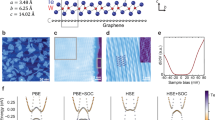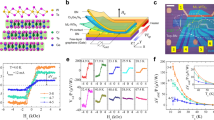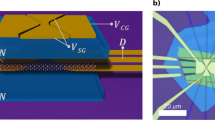Abstract
A two-dimensional topological insulator (2DTI) is guaranteed to have a helical one-dimensional edge mode1,2,3,4,5,6,7,8,9,10,11 in which spin is locked to momentum, producing the quantum spin Hall effect and prohibiting elastic backscattering at zero magnetic field. No monolayer material has yet been shown to be a 2DTI, but recently the Weyl semimetal WTe2 was predicted12 to become a 2DTI in monolayer form if a bulk gap opens. Here, we report that, at temperatures below about 100 K, monolayer WTe2 does become insulating in its interior, while the edges still conduct. The edge conduction is strongly suppressed by an in-plane magnetic field and is independent of gate voltage, save for mesoscopic fluctuations that grow on cooling due to a zero-bias anomaly, which reduces the linear-response conductance. Bilayer WTe2 also becomes insulating at low temperatures but does not show edge conduction. Many of these observations are consistent with monolayer WTe2 being a 2DTI. However, the low-temperature edge conductance, for contacts spacings down to 150 nm, never reaches values higher than ∼20 μS, about half the predicted value of e2/h, suggesting significant elastic scattering in the edge.
This is a preview of subscription content, access via your institution
Access options
Access Nature and 54 other Nature Portfolio journals
Get Nature+, our best-value online-access subscription
$32.99 / 30 days
cancel any time
Subscribe to this journal
Receive 12 print issues and online access
$259.00 per year
only $21.58 per issue
Buy this article
- Purchase on SpringerLink
- Instant access to full article PDF
Prices may be subject to local taxes which are calculated during checkout




Similar content being viewed by others
References
Kane, C. & Mele, E. A new spin on the insulating state. Science 314, 1692–1693 (2006).
Hasan, M. Z. & Kane, C. L. Colloquium: topological insulators. Rev. Mod. Phys. 82, 3045–3067 (2010).
Qi, X.-L. & Zhang, S.-C. Topological insulators and superconductors. Rev. Mod. Phys. 83, 1057–1110 (2011).
Bernevig, B. A., Hughes, T. L. & Zhang, S.-C. Quantum spin Hall effect and topological phase transition in HgTe quantum wells. Science 314, 1757–1761 (2006).
König, M. et al. Quantum spin Hall insulator state in HgTe quantum wells. Science 318, 766–770 (2007).
Roth, A. et al. Nonlocal transport in the quantum spin Hall state. Science 325, 294–297 (2009).
Gusev, G. M. et al. Transport in disordered two-dimensional topological insulators. Phys. Rev. B 84, 121302(R) (2011).
König, M. et al. Spatially resolved study of backscattering in the quantum spin Hall state. Phys. Rev. X 3, 021003 (2013).
Knez, I., Du, R.-R. & Sullivan, G. Evidence for helical edge modes in inverted InAs/GaSb quantum wells. Phys. Rev. Lett. 107, 136603 (2011).
Suzuki, K., Harada, Y., Onomitsu, K. & Muraki, K. Edge channel transport in the InAs/GaSb topological insulating phase. Phys. Rev. B 87, 235311 (2013).
Li, T. et al. Observation of a helical Luttinger liquid in InAs/GaSb quantum spin Hall edges. Phys. Rev. Lett. 115, 136804 (2015).
Qian, X., Liu, J., Fu, L. & Li, J. Quantum spin Hall effect in two-dimensional transition metal dichalcogenides. Science 346, 1344–1347 (2014).
Nowack, K. C. et al. Imaging currents in HgTe quantum wells in the quantum spin Hall regime. Nat. Mater. 12, 787–791 (2013).
Spanton, E. M. et al. Images of edge current in InAs/GaSb quantum wells. Phys. Rev. Lett. 113, 026804 (2014).
Xu, C. & Moore, J. E. Stability of the quantum spin Hall effect: effects of interactions, disorder, and Z2 topology. Phys. Rev. B 73, 045322 (2006).
Maciejko, J. et al. Kondo effect in the helical edge liquid of the quantum spin Hall state. Phys. Rev. Lett. 102, 256803 (2009).
Tanaka, Y., Furusaki, A. & Matveev, K. A. Conductance of a helical edge liquid coupled to a magnetic impurity. Phys. Rev. Lett. 106, 236402 (2011).
Altshuler, B. L. et al. Localization at the edge of a 2D topological insulator by Kondo impurities with random anisotropies. Phys. Rev. Lett. 111, 086401 (2013).
Cheianov, V. & Glazman, L. I. Mesoscopic fluctuations of conductance of a helical edge contaminated by magnetic impurities. Phys. Rev. Lett. 110, 206803 (2013).
Väyrynen, J. I. et al. Resistance of helical edges formed in a semiconductor heterostructure. Phys. Rev. B 90, 115309 (2014).
Du, L., Knez, I., Sullivan, G. & Du, R.-R. Robust helical edge transport in gated InAs/GaSb bilayers. Phys. Rev. Lett. 114, 096802 (2015).
Ma, E. Y. et al. Unexpected edge conduction in mercury telluride quantum wells under broken time-reversal symmetry. Nat. Commun. 6, 7252 (2015).
Vera-Marun, I. J. et al. Quantum Hall transport as a probe of capacitance profile at graphene edges. Appl. Phys. Lett. 102, 013106 (2013).
Soluyanov, A. A. et al. Type-II Weyl semimetals. Nature 527, 495–498 (2015).
Wu, Y. et al. Observation of Fermi arcs in the type-II Weyl semimetal candidate WTe2 . Phys. Rev. B 94, 121113 (2016).
Ali, M. N. et al. Large, non-saturating magnetoresistance in WTe2 . Nature 514, 205–208 (2014).
Zhao, Y. F. et al. Anisotropic magnetotransport and exotic longitudinal linear magnetoresistance in WTe2 crystals. Phys. Rev. B 92, 206803(R) (2015).
Pletikosic, I., Ali, M. N., Fedorov, A. V., Cava, R. J. & Valla, T. Electronic structure basis for the extraordinary magnetoresistance in WTe2 . Phys. Rev. Lett. 113, 216601 (2014).
Cai, P. L. et al. Drastic pressure effect on the extremely large magnetoresistance in WTe2: quantum oscillation study. Phys. Rev. Lett. 115, 057202 (2015).
Lv, H. Y. et al. Perfect charge compensation in WTe2 for the extraordinary magnetoresistance: from bulk to monolayer. Europhys. Lett. 110, 37004 (2015).
Altshuler, B. L. & Aronov, A. G. Zero bias anomaly in tunnel resistance and electron-electron interaction. Solid State Commun. 30, 115–117 (1979).
Wu, C. J., Bernevig, B. A. & Zhang, S. C. Helical liquid and the edge of quantum spin Hall systems. Phys. Rev. Lett. 96, 106401 (2006).
Schmidt, T. L., Rachel, S., von Oppen, F. & Glazman, L. I. Inelastic electron backscattering in a generic helical edge channel. Phys. Rev. Lett. 108, 156402 (2012).
Väyrynen, J. I., Geissler, F. & Glazman, L. I. Magnetic moments in a helical edge can make weak correlations seem strong. Phys. Rev. B 93, 241301(R) (2016).
Bahlouli, H., Matveev, K. A., Ephron, D. & Beasley, M. R. Coulomb correlations in hopping through a thin layer. Phys. Rev. B 49, 14496–14503 (1994).
Ioffe, L. B. & Spivak, B. Z. Giant magnetoresistance in the variable-range hopping regime. J. Exp. Theor. Phys. 117, 551–569 (2013).
Kane, C. L. & Fisher, M. P. A. Transport in a one-channel Luttinger liquid. Phys. Rev. Lett. 68, 1220–1223 (1992).
Furusaki, A. & Nagaosa, N. Single-barrier problem and Anderson localization in a one-dimensional interacting electron system. Phys. Rev. B 47, 4631–4643 (1993).
Kohn, W. Excitonic phases. Phys. Rev. Lett. 19, 439–442 (1967).
Cercellier, H. et al. Evidence for an excitonic insulator phase in 1T-TiSe2 . Phys. Rev. Lett. 99, 146403 (2007).
Huang, C. M. et al. Lateral heterojunctions within monolayer MoSe2-WSe2 semiconductors. Nat. Mater. 13, 1096–1101 (2014).
Fu, L. & Kane, C. L. Superconducting proximity effect and majorana fermions at the surface of a topological insulator. Phys. Rev. Lett. 100, 096407 (2008).
Zomer, P. J., Guimaraes, M. H. D., Brant, J. C., Tombros, N. & van Wees, B. J. Fast pick up technique for high quality heterostructures of bilayer graphene and hexagonal boron nitride. Appl. Phys. Lett. 105, 013101 (2014).
Dean, C. R. et al. Boron nitride substrates for high-quality graphene electronics. Nat. Nanotech. 5, 722–726 (2010).
Acknowledgements
We thank J. Yan (Oak Ridge National Laboratory) for providing the WTe2 crystals, and A. Andreev, L. Glazman, J. Maciejko, K. Matveev, J. Moore, B. Spivak, J. Väyrynen and D. Xiao for discussions. The major part of this work was supported by the US Department of Energy, Office of Basic Energy Sciences, Division of Materials Sciences and Engineering, Awards DE-SC0002197 (D.H.C.) and DE-SC0012509 (X.X.). T.P. and Z.F. were supported by AFOSR FA9550-14-1-0277. P.N., J.F. and some facilities were supported by NSF EFRI 2DARE 1433496.
Author information
Authors and Affiliations
Contributions
D.H.C. and X.X. conceived the experiment; Z.F., T.P., S.W. and D.H.C. performed the measurements; Z.F., W.Z., S.W., T.P., X.C., B.S., P.N. and J.F. fabricated the devices; D.H.C., X.X., Z.F. and T.P. analysed the results; and D.H.C., Z.F., T.P. and X.X. wrote the paper with comments from all authors.
Corresponding authors
Ethics declarations
Competing interests
The authors declare no competing financial interests.
Supplementary information
Supplementary information
Supplementary information (PDF 1975 kb)
Rights and permissions
About this article
Cite this article
Fei, Z., Palomaki, T., Wu, S. et al. Edge conduction in monolayer WTe2. Nature Phys 13, 677–682 (2017). https://doi.org/10.1038/nphys4091
Received:
Accepted:
Published:
Issue date:
DOI: https://doi.org/10.1038/nphys4091
This article is cited by
-
Realization of a one-dimensional topological insulator in ultrathin germanene nanoribbons
Nature Communications (2025)
-
Platforms for the realization and characterization of Tomonaga–Luttinger liquids
Nature Reviews Physics (2025)
-
Polarized optical contrast spectroscopy of in plane anisotropic van der Waals materials
Scientific Reports (2025)
-
Charge-neutral electronic excitations in quantum insulators
Nature (2024)
-
A first-principles study of bilayer 1T'-WTe2/CrI3: a candidate topological spin filter
npj Spintronics (2024)



